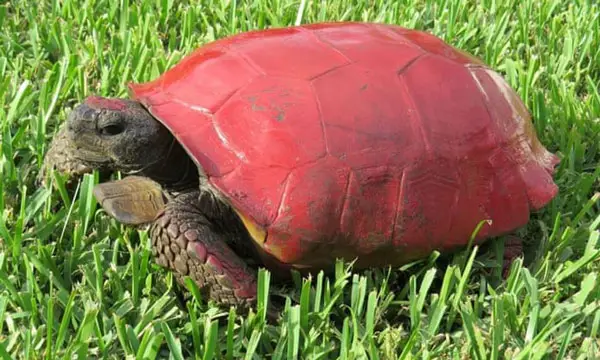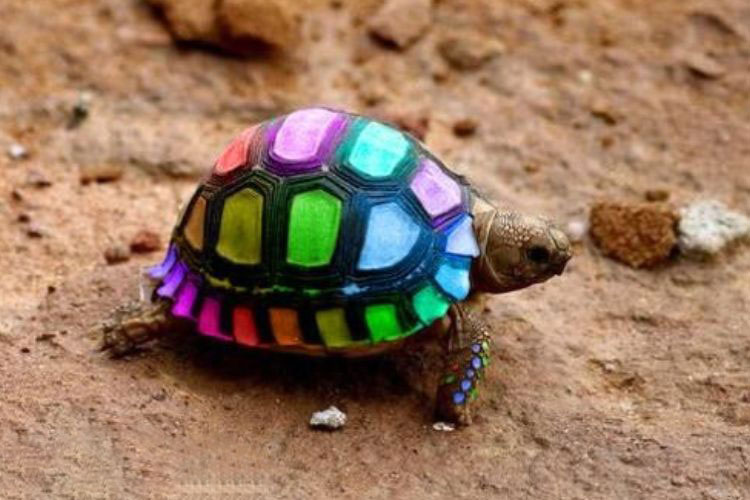Can You Paint a Turtle Shell?- Is It Harmful To Turtles?
The most distinct feature of turtles and tortoises is their shells. The shells have elaborate designs which add to their natural beauty. Painting a turtle’s shell is not good. Here is why.
Can you paint a turtle shell? No, you cannot. Shells of turtles permit toxic chemicals from paint to enter the turtles’ bodies. This can lead to serious health issues, which can lead to death. Paint also makes the turtle’s shell less absorbent to UV light and destroys the whole concept of camouflage.
Many people think it is “cool” to paint their turtles’ shells. However, in reality, it is very harmful to the turtle. This article will go over whether you can paint a turtle shell and why it is dangerous to paint a turtle’s shell.
Can You Paint A Turtle Shell?
Contents
No, you can’t. The fact that turtle shells are made of keratin is why people believe they can paint them. Keratin is the same material found on human nails. People think that because we paint our nails with nail polish, we can also paint our turtle’s shell.
Even when you apply nail polish to your fingernails, the fumes are very unpleasant. Consider how your pet turtle would react if you covered 90% of its body in the same toxic fumes. Furthermore, turtle shells are porous, allowing chemicals to enter the turtle’s body.

Turtle shells absorb sunlight, which aids in the production of vitamin D3. This vitamin is essential because it aids the body in synthesizing calcium, which is necessary for bone development. If you paint the turtle’s shell, the chemicals may harm it.
Some people even use permanent paint to decorate the shells of their turtles. Others use a color that is said to be safe for turtles. However, it is best to avoid using paint for your turtle’s health.
Why Is Painting a Turtle Shell Dangerous?
Turtles generally do not show when they’re in pain. So you would not know if your turtle is in pain until it is too late. As we have already established, painting your turtle is harmful and here is why:

Toxicity
The turtle’s shell will let chemicals from the paint seep into the turtle’s body. The chemicals will toxify the turtle’s blood, leading to blood poisoning or septicemia. Also, the turtle’s shell has many nerve endings that are very vulnerable to these toxic chemicals.
Most paints contain turpentine, acetone, and formaldehyde which are all toxic and pose serious health issues. These chemicals are hazardous, even in small amounts. Now imagine what damage they could do if they were all over the turtle’s shell. Blood poisoning is fatal and can result in death.
Less absorption of sunlight
The turtle absorbs most UV light through its shell. The turtles require sunlight to regulate their body temperature. Also, sunlight is important because it helps the turtle produce vitamin D.
So by painting your turtle, you make the shell less absorbent. If your turtle is not getting enough sunlight, it could lead to complications such as vitamin deficiency.
Overheating
Turtles lose their heat through their shells when they are in hot environments. A painted turtle cannot emit heat well, which could lead to overheating.

Overheating can cause a box turtle to suffocate and die because the turtle cannot go outside to get fresh air. Freshwater turtles will likely enter the water to cool themselves off, but that does not mean you should paint them.
Also read: Do Turtles Have Periods?
Ailments
The paint contains chemicals that can cause the turtle to have respiratory diseases. Paint fumes will hover around the turtle, and the turtle will have no choice but to inhale them.
So as much as you think your turtle needs to look pretty in all the colors, consider the health risk you are exposing it to.
Shell deformities
Wildlife officials observed that most wild turtles with painted shells have deformities. Some of the deformities included; stunted growth, their shells softening, or abnormal pyramiding. A deformed shell means that the turtle is at risk of internal injuries.
Camouflage
The turtle’s shell does not have vibrant colors for the sole purpose of camouflage. The dull colors serve as the turtle’s natural camouflage making the turtle less noticeable in the wild. When you paint the turtle, it takes away its defense.
A turtle with a colorful shell will be the point of focus for predators. Turtles are already an endangered species; painting them just minimizes their chances of survival.
Is It Possible to Paint a Turtle’s Shell in a Safe Way?
Some people argue that water-based paints and some acrylic paints are safe to use on your turtle. They consider them safe because they can wash off easily. However, there is no safe way to paint a turtle’s shell.
Most paints contain harmful chemicals, which can lead to adverse health conditions. Effects of paint on the turtle remain the same irrespective of the paint you use. This is because all paint contains toxins and forms a toxic coat on your turtle’s shell.

So, ignore anyone telling you there are any safe paints for turtles. Avoid all stains, whether acrylic, water-based, markers, wax, or oil paints. You would rather have a turtle with boring, dull colors than a sick turtle.
Related Questions
Here are other frequently asked questions.
No, it is not safe. Nail polish contains toxic chemicals such as acetone. These chemicals can be very hazardous when leeching the turtle’s skin. Nail polish, like all other paints, can cause respiratory diseases and shell deformities.
Yes, it can. If you find a wild turtle with a painted shell, take it to the nearest animal rescue. Do not try to wash off the paint with detergents and soaps. Cleaning paint off a turtle is an intricate process that requires a specialist. The specialist performs multiple washing sessions before the turtle is clean.
Related: How To Trim A Turtle’s Nail?
Conclusion
Paint is not safe for turtles. Even turtle-safe paints are not okay to put on a turtle’s shell. Not only can paint lead to illnesses, but it can also lead to death. So keep away from painting your turtle’s shell and if you come across a wild turtle with an already painted exterior, take it to a veterinarian.
Turtles are beautiful just the way they are. So, do not cover their natural beauty with unpleasant coats of paint. We hope this article answers the question, can you paint a turtle shell?


